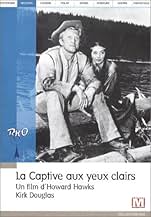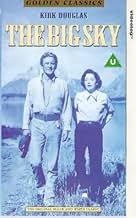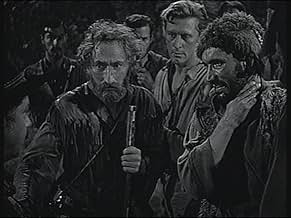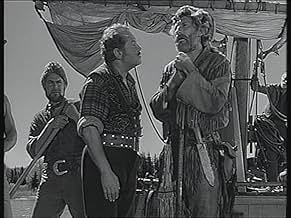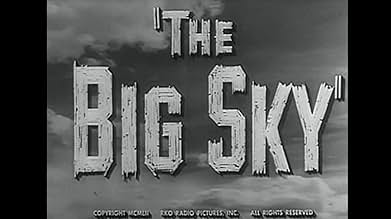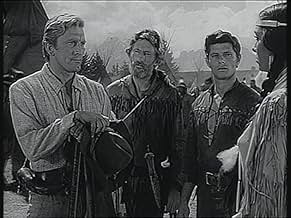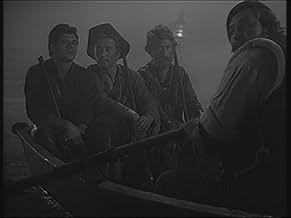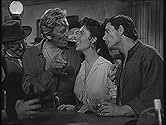Der Erfolg der Reise konzentriert sich darauf, das Indianermädchen am Leben zu erhalten und selbst den Handel mit den Blackfeet abzuschließen.Der Erfolg der Reise konzentriert sich darauf, das Indianermädchen am Leben zu erhalten und selbst den Handel mit den Blackfeet abzuschließen.Der Erfolg der Reise konzentriert sich darauf, das Indianermädchen am Leben zu erhalten und selbst den Handel mit den Blackfeet abzuschließen.
- Für 2 Oscars nominiert
- 3 Nominierungen insgesamt
- Blackfoot Dancer
- (Nicht genannt)
- Horse Trader
- (Nicht genannt)
- Tavern Patron
- (Nicht genannt)
- Tavern Proprietor
- (Nicht genannt)
- Tavern Patron
- (Nicht genannt)
- Jailer
- (Nicht genannt)
- Blackfoot Subchief
- (Nicht genannt)
- Pascal
- (Nicht genannt)
Empfohlene Bewertungen
1832 and Jim Deakins (Douglas) & Boone Caudill (Martin) meet by chance out in the wilderness. Quickly bonding they travel to St Louis together to seek out Boone's Uncle Zeb (Hunnicutt). After finding him via a bar room brawl, the two men agree to join Zeb in a venture up the Missouri river to trade fur with the unpredictable Blackfoot Indians; their insurance against attack by the Blackfoot coming courtesy of Teal Eye (Threatt), a beautiful Blackfoot princess kidnapped years previously and now being returned home. Along the way the party have to battle nature, the Indian factions and also the Missouri Company out to topple their enterprise for fear of losing their monopoly on trade. Perhaps worse still is that the new found friendship between Boone & Jim will be tested by their mutual attraction to Teal Eye?
Given the credentials that come with The Big Sky, it's a little surprising that it's not more well known. Hawks, Douglas and Tiomkin speak for themselves, while Guthrie wrote the script for Shane and Nichols wrote the screenplay for John Ford's 1939 pulse raiser, Stagecoach. Add in that Hunnicutt and Harlan were Academy Award nominated for Best Support Actor and Cinematography respectively, well you have a fine bunch of professionals involved with this movie. So why so ignored or forgotten? The starting point should be with Hawks himself, who openly had issues with the finished product. Originally the film was a huge 140 minutes long and was doing decent business at the box office. But the studio execs had it cut down to 122 minutes so as to fit one more screening in during the day. The film promptly flopped and was left for dead by director and studio. Hawks was also never fully behind Douglas in the role of Deakins, he had wanted Gary Cooper or John Wayne. It seems in the end that Hawks just walked away after release and lost faith in promoting it. Western fans were grateful that the experience didn't make him turn his back on the genre, tho, for he delivered Rio Bravo 7 years later.
Having not seen the full uncut version of the film, I personally have to say that the 122 minute version viewed was pretty uneven and lacking a certain narrative spark to make it fully work. It's even episodic for the most part. What isn't in doubt is that visually it's one of Hawks' most rewarding pictures, with Harlan's photography sumptuous and period perfecto. Douglas is spirited and plays the black humour within quite nicely, while Martin is good foil for Douglas' beaming machismo, even if he's just a little too animated at times. Threatt doesn't have to do anything other than smile and look pretty, while Hank Worden shows up to neatly play a buffoon Indian called Poordevil! Undoubtedly the star of the show is Hunnicutt (who also narrates), tucking into a boozy, grizzled, teller of tall tales character, Hunnicutt lifts the film on the frequent occasions it threatens to sag beyond repair.
With the visuals and enjoyable Hawksian take on "man love" the film is worth the time of any Western fan. While the efforts to resist racism are honourable and neatly played. But in the end Hawks' frustration is justified, for it feels like a patched together adventure piece. And certainly not one that makes you think it's directed by the man who made Red River. I wouldn't hesitate to watch the full 140 minute cut of the film, but until then it will be some time before I can see myself watching this version again. 6/10
Footnote: Some Region 2 DVD's exist of the full cut, where the cut scenes have been spliced back in from a 16mm print. I'm led to believe that the quality is far from great. For British readers, the 122 minute cut shows up once in a blue moon on TV, where the BBC have the rights so at least it is advertisement free. As yet there is still no Region 1 release for the film.
The Big Sky was RKO Pictures big production for 1952. I'd like to say that Howard Hughes spared no expense in making this film, shooting a good deal of it in the Grand Tetons, the actual location for the adventures of many fur trappers. But for the life of me I don't understand why Hughes and RKO after doing that, didn't spring for color.
Possibly because director Howard Hawks wanted black and white. His last epic film Red River had done well in black and white. Still I really think something was missed. RKO did use color on films with a lot less budget.
There's a lot of similarity between The Big Sky and Red River. Both films involve a group of men on an epic journey into the unknown for business reasons. In Red River, John Wayne has to get that huge herd to market and has to use a trail few have used. In The Big Sky a group of independent trappers basically want to land a nice fur contract with the Blackfeet Indians where few whites have gone up the Missouri River. Going against them is a fur trading consortium kind of like the one John Jacob Astor put together.
The trappers are mostly French Canadian Metis headed by Steven Geray, but also along is Arthur Hunnicutt who speaks the Indian language. Their ace in the hole is Elizabeth Threatt, a Blackfoot princess the trappers have rescued and are bringing back to her people in the hopes that her old man will be grateful. Hunnicutt is also the narrator of the film.
Douglas and Dewey Martin join up with the group in St. Louis and the trappers have the usual adventures as they take the flatboat up into the Missouri River country. The scenes showing journey upriver are nicely photographed.
Two others in the cast merit attention. Hank Worden does a nice job as a lost Blackfoot Indian who the trappers pick up. He may not be playing with a full deck, but he does come in handy. Jim Davis is one lean and mean villain as the company troubleshooter who wants to keep the independents out.
Arthur Hunnicutt got an Oscar nomination for Best Supporting Actor for his role, The Big Sky proved to be his career film. Unfortunately he lost to Anthony Quinn for Viva Zapata. Still Hunnicutt's folksy charm was always something to look forward to in any film he was ever in.
The Big Sky is one of the best films ever done about the mountain man era of the American frontier. If they'd only spent for color.
Well worth your time and any children should be shown it as well because they'll remember it throughout their lives. I certainly have!
Follows an incomplete exposition of the other merits of "The big sky". The film is brilliantly made and interpreted. The actors are all outstanding. Arthur Hunnicutt dominates. Kirk Douglas' natural dynamic way is perfect for his role. Dewey Martin is excellent, as well. Special mentions to Elizabeth Threatt as Teal Eye and to Hank Worden as the funny but smart Poordevil. The black and white photography is magnificent. Indeed, only black and white seems capable to render the incredible bright of Threatt's eyes. And it fully respects and gives depth to the beauty of nature.
As usual in Howard Hawks' works, the movie is based on swift-pace-action amalgamated with the human interaction of the characters. Here we have a world with no established laws, out of those of nature. People survive if they recognize who is a friend and who is an enemy, independently on being white or native. The mixture of languages, English, French, Native, and related, often funny, translations, is a fine device to give realism to the script. The love story develops at the rhythm of nature, similarly to the endless journey of the keel-boat, and it's even touching at the ending. We also see that irrational hate is not just criminal nonsense, it's even ridiculous.
It seems that "The big sky" was considerably cut by the studios. In fact, some magnificent choral scenes appears to be too short. One instance for all: the paramount scene of the Blackfeet hauling the keel-boat on the river lasts just few seconds. To cut the film was certainly a very bad idea. Fortunately, "The big sky" remains a masterpiece, worth of Hawks' immense talent and genius. Well, it's enough clear that I like this movie. Indeed, I strongly believe that Howard Hawks was born to give us joy. "The big sky" is a major evidence in favor of my opinion.
Wusstest du schon
- WissenswertesWhile shooting Panik am roten Fluß (1948), there was a scene that director Howard Hawks unsuccessfully urged John Wayne to do. It involved his getting a finger mangled between a saddle horn and a rope, resulting in Walter Brennan's amputating it. Hawks reportedly told Wayne, "If you're not good enough, we won't do it", but Wayne wouldn't do it. According to Hawks biographer Todd McCarthy, Hawks did get Kirk Douglas to do that scene in this film, and it came off so funny that Wayne later declared to Hawks, "If you tell me a funeral is funny, I'll do a funeral."
- PatzerJim expresses amazement at the size of St. Louis. However, he had just come from Louisville, which in 1832 was about twice the size of St. Louis, so it should not have been a source of such astonishment.
- Zitate
Zeb Calloway: Blackfeet... proud injuns. They ain't gonna let no white man spile their country. The only thing they'a feared of is a white man's sickness.
Boone Cardell: What's that?
Zeb Calloway: Grabs. White men don't see nothing pretty unless they want to grab it. The more they grab, the more they want to grab. It's like a fever and they can't get cured. The only thing for them to do is to keep on grabbin' until everything belongs to white men and then start grabbin' from each other. I reckon injuns got no reason to love nothing white.
- Crazy CreditsInstead of the traditional RKO morse code sound, the film's opening theme music is played over the RKO radio tower image. Later, a title card is displayed explaining the premise of the story.
- VerbindungenReferenced in Rette deine Haut, Killer (1981)
Top-Auswahl
Details
- Erscheinungsdatum
- Herkunftsland
- Sprachen
- Auch bekannt als
- Río de sangre
- Drehorte
- Produktionsfirmen
- Weitere beteiligte Unternehmen bei IMDbPro anzeigen
Box Office
- Budget
- 2.000.000 $ (geschätzt)
- Laufzeit
- 1 Std. 35 Min.(95 min)
- Farbe
- Seitenverhältnis
- 1.37 : 1


